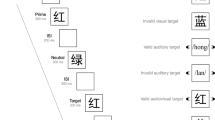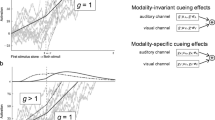Abstract
Multisensory integration is known to create a more robust and reliable perceptual representation of one’s environment. Specifically, a congruent auditory input can make a visual stimulus more salient, consequently enhancing the visibility and detection of the visual target. However, it remains largely unknown whether a congruent auditory input can also impair visual processing. In the current study, we demonstrate that temporally congruent auditory input disrupts visual processing, consequently slowing down visual target detection. More importantly, this cross-modal inhibition occurs only when the contrast of visual targets is high. When the contrast of visual targets is low, enhancement of visual target detection is observed, consistent with the prediction based on the principle of inverse effectiveness (PIE) in cross-modal integration. The switch of the behavioral effect of audiovisual interaction from benefit to cost further extends the PIE to encompass the suppressive cross-modal interaction.



Similar content being viewed by others
References
Alais D, van Boxtel JJ, Parker A, van Ee R (2010) Attending to auditory signals slows visual alternations in binocular rivalry. Vis Res 50:929–935
Albrecht DG, Hamilton DB (1982) Striate cortex of monkey and cat: contrast response function. J Physiol 48:217–237
Alsius A, Munhall KG (2013) Detection of audiovisual speech correspondences without visual awareness. Psychol Sci 24(4):423–431
Brainard DH (1997) The psychophysics toolbox. Spatial Vis 10:433–436
Chen YC, Yeh SL, Spence C (2011) Crossmodal constraints on human perceptual awareness: auditory semantic modulation of binocular rivalry. Front Psychol 2:212. doi:10.3389/fpsyg.2011.00212
Chong SC, Blake R (2006) Exogenous attention and endogenous attention influence initial dominance in binocular rivalry. Vis Res 46:1794–1803
Chong SC, Tadin D, Blake R (2005) Endogenous attention prolongs dominance durations in binocular rivalry. J Vis 5:1004–1012
Conrad V, Bartels A, Kleiner M, Noppeney U (2010) Audiovisual interactions in binocular rivalry. J Vis 10:27
Conrad V, Vitello MP, Noppeney U (2012) Interactions between apparent motion rivalry in vision and touch. Psychol Sci 23:940–948
Convento S, Vallar G, Galantini C, Bolognini N (2013) Neuromodulation of early multisensory interactions in the visual cortex. J Cogn Neurosci 25(5):685–696
Cox D, Hong SW (2015) Semantic-based crossmodal processing during visual suppression. Front Psychol 6:722. doi:10.3389/fpsyg.2015.00722
Diederich A, Colonius H (2004) Bimodal and trimodal multisensory enhancement: effects of stimulus onset and intensity on reaction time. Percept Psychophys 66:188–1404
Driver J, Noesselt T (2008) Multisensory interplay reveals crossmodal influences on ‘‘sensory specific” brain regions, neural responses, and judgments. Neuron 57:11–23
Fiebelkorn IC, Foxe JJ, Butler JS, Molholm S (2011) Auditory facilitation of visual-target detection persists regardless of retinal eccentricity and despite wide audiovisual misalignments. Exp Brain Res 213:167–174
Gayet S, Van der Stigchel S, Paffen CLE (2014) Breaking continuous flash suppression: competing for consciousness on the pre-semantic battlefield. Front Psychol 5:460. doi:10.3389/fpsyg.2014.00460
Guzman-Martinez E, Ortega L, Grabowecky M, Mossbridge J, Suzuki S (2012) Interactive coding of visual spatial frequency and auditory amplitude-modulation rate. Curr Biol 22:383–388
Iurilli G, Ghezzi D, Olcese U, Lassi G, Nazzaro C, Tonini R, Tucci V, Benfenati F, Medini P (2012) Sound-driven synaptic inhibition in primary visual cortex. Neuron 73:814–828
Kadunce DC, Vaughan JW, Wallace MT, Benedek G, Stein BE (1997) Mechanisms of within- and cross-modality suppression in the superior colliculus. J Neurophysiol 78(6):2834–2847
Kang M-S, Blake R, Woodman GF (2011) Semantic analysis does not occur in the absence of awareness induced by interocular suppression. J Neurosci 31:13535–13545
Keetels M, Stekelenburg J, Vroomen J (2007) Auditory grouping occurs prior to intersensory pairing: evidence from temporal ventriloquism. Exp Brain Res 180:449–456
Ling S, Carrasco M (2006) When sustained attention impairs perception. Nat Neurosci 9:1243–1245
Lippert M, Logothetis NK, Kayser C (2007) Improvement of visual contrast detection by a simultaneous sound. Brain Res 1173:102–109
Lunghi C, Alais D (2013) Touch interacts with vision during binocular rivalry with a tight orientation tuning. PLoS One 8:e58754
Lunghi C, Alais D (2015) Congruent tactile stimulation reduces the strength of visual suppression during binocular rivalry. Sci Rep 5:9413. doi:10.1038/srep09413
Lunghi C, Binda P, Morrone MC (2010) Touch disambiguates rivalrous perception at early stages of visual analysis. Curr Biol 20:R143–R144
Lunghi C, Morrone MC, Alais D (2014) Auditory and tactile signals combine to influence vision during binocular rivalry. J Neurosci 34(3):784–792
Meredith MA, Stein BE (1986) Visual, auditory, and somatosensory convergence on cells in superior colliculus results in multisensory integration. J Neurophysiol 56:640–662
Moors P, Huygelier H, Wagemans J, de Wit L, van Ee R (2015) Suppressed visual looming stimuli are not integrated with auditory looming signals: evidence from continuous flash suppression. Perception 6:48–62
Noesselt T, Rieger JW, Schoenfeld MA, Kanowski M, Hinrichs H, Heinze HJ, Driver J (2007) Audiovisual temporal correspondence modulates human multisensory superior temporal sulcus plus primary sensory cortices. J Neurosci 27:11431–11441
Noesselt T, Bergmann D, Hake M, Heinze HJ, Fendrich R (2008) Sound increases the saliency of visual events. Brain Res 1220:157–163
Noesselt T, Tyll S, Boehler CN, Heinze HJ, Driver J (2010) Sound-induced enhancement of low-intensity vision: multisensory influences on human sensory-specific cortices and thalamic bodies relate to perceptual enhancement of visual detection sensitivity. J Neurosci 30:13609–13623
Paffen CL, Alais D, Verstraten FA (2006) Attention speeds binocular rivalry. Psychol Sci 17:752–756
Pelli DG (1997) The VideoToolbox software for visual psychophysics: transforming numbers into movies. Spatial Vis 10:437–442
Plass J, Guzman-Martinez E, Ortega L, Grabowecky M, Suzuki S (2014) Lipreading without awareness. Psychol Sci 25(9):1835–1837
Romei V, Murray MM, Cappe C, Thut G (2009) Preperceptual and stimulus-selective enhancement of low-level human visual cortex excitability by sounds. Curr Biol 19:1799–1805
Romei V, Gross J, Thut G (2012) Sounds reset rhythms of visual cortex and corresponding human visual perception. Curr Biol 22:807–813
Stanford TR, Quessy S, Stein BE (2005) Evaluating the operations underlying multisensory integration in the cat superior colliculus. J Neurosci 25:6499–6508
Stein BE, Meredith MA (1993) The merging of the senses. MIT Press, Cambridge
Stein T, Sterzer P (2014) Unconscious processing under interocular suppression: getting the right measure. Front Psychol 5:387. doi:10.3389/fpsyg.2014.00387
Stein BE, London N, Wilkonson LK, Price DD (1996) Enhancement of perceived visual intensity by auditory stimuli: a psychophysical analysis. J Cogn Neurosci 8(6):497–506
Talsma D, Senkowski D, Soto-Faraco S, Woldorff MG (2010) The multifaceted interplay between attention and multisensory integration. Trends Cogn Sci 14(9):400–410
Tsuchiya N, Koch C (2005) Continuous flash suppression reduces negative afterimages. Nat Neurosci 8(8):1096–1101
Tsuchiya N, Koch C, Gilroy L, Blake R (2006) Depth of interocular suppression associated with continuous flash suppression, flash suppression, and binocular rivalry. J Vis 6:1068–1078
Van der Burg E, Olivers CNL, Bronkhorst AW, Theeuwes J (2008) Pip and Pop: nonspatial Auditory Signals Improve Spatial Visual Search. J Exp Psychol Hum Percep Perform 34:1053–1065
van Ee R, van Boxtel JJ, Parker AL, Alais D (2009) Multisensory congruency as a mechanism for attentional control over perceptual selection. J Neurosci 29:11641–11649
Vroomen J, de Gelder B (2000) Sound enhances visual perception: cross-modal effects of auditory organization on vision. J Exp Psychol Hum Percep Perform 26(5):1583–1590
Werner S, Noppeney U (2010) Superadditive responses in superior temporal sulcus predict audiovisual benefits in object categorization. Cereb Cortex 20:1829–1842
Author information
Authors and Affiliations
Corresponding author
Ethics declarations
Conflict of interest
The authors declared that they had no conflicts of interest with respect to their authorship or the publication of this article.
Rights and permissions
About this article
Cite this article
Hong, S.W., Shim, W.M. When audiovisual correspondence disturbs visual processing. Exp Brain Res 234, 1325–1332 (2016). https://doi.org/10.1007/s00221-016-4591-y
Received:
Accepted:
Published:
Issue Date:
DOI: https://doi.org/10.1007/s00221-016-4591-y




